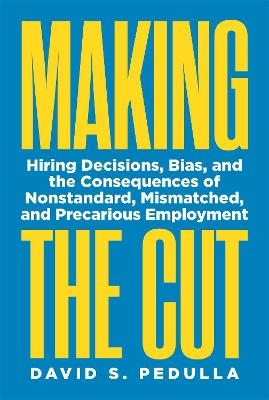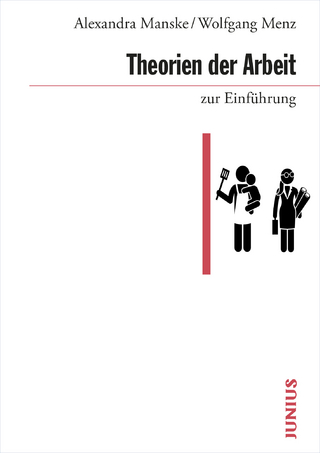
Making the Cut
Hiring Decisions, Bias, and the Consequences of Nonstandard, Mismatched, and Precarious Employment
Seiten
2020
Princeton University Press (Verlag)
978-0-691-17510-2 (ISBN)
Princeton University Press (Verlag)
978-0-691-17510-2 (ISBN)
An in-depth look at how employers today perceive and evaluate job applicants with nonstandard or precarious employment historiesMillions of workers today labor in nontraditional situations involving part-time work, temporary agency employment, and skills underutilization or face the precariousness of long-term unemployment. To date, research ha
An in-depth look at how employers today perceive and evaluate job applicants with nonstandard or precarious employment histories
Millions of workers today labor in nontraditional situations involving part-time work, temporary agency employment, and skills underutilization or face the precariousness of long-term unemployment. To date, research has largely focused on how these experiences shape workers’ well-being, rather than how hiring agents perceive and treat job applicants who have moved through these positions. Shifting the focus from workers to hiring agents, Making the Cut explores how key gatekeepers—HR managers, recruiters, and talent acquisition specialists—evaluate workers with nonstandard, mismatched, or precarious employment experience. Factoring in the social groups to which workers belong—such as their race and gender—David Pedulla shows how workers get jobs, how the hiring process unfolds, who makes the cut, and who does not.
Drawing on a field experiment examining hiring decisions in four occupational groups and in-depth interviews with hiring agents in the United States, Pedulla documents and unpacks three important discoveries. Hiring professionals extract distinct meanings from different types of employment experiences; the effects of nonstandard, mismatched, and precarious employment histories for workers’ job outcomes are not all the same; and the race and gender of workers intersect with their employment histories to shape which workers get called back for jobs. Indeed, hiring professionals use group-based stereotypes to weave divergent narratives or “stratified stories” about workers with similar employment experiences. The result is a complex set of inequalities in the labor market.
Looking at bias and discrimination, social exclusion in the workplace, and the changing nature of work, Making the Cut probes the hiring process and offers a clearer picture of the underpinnings of getting a job in the new economy.
An in-depth look at how employers today perceive and evaluate job applicants with nonstandard or precarious employment histories
Millions of workers today labor in nontraditional situations involving part-time work, temporary agency employment, and skills underutilization or face the precariousness of long-term unemployment. To date, research has largely focused on how these experiences shape workers’ well-being, rather than how hiring agents perceive and treat job applicants who have moved through these positions. Shifting the focus from workers to hiring agents, Making the Cut explores how key gatekeepers—HR managers, recruiters, and talent acquisition specialists—evaluate workers with nonstandard, mismatched, or precarious employment experience. Factoring in the social groups to which workers belong—such as their race and gender—David Pedulla shows how workers get jobs, how the hiring process unfolds, who makes the cut, and who does not.
Drawing on a field experiment examining hiring decisions in four occupational groups and in-depth interviews with hiring agents in the United States, Pedulla documents and unpacks three important discoveries. Hiring professionals extract distinct meanings from different types of employment experiences; the effects of nonstandard, mismatched, and precarious employment histories for workers’ job outcomes are not all the same; and the race and gender of workers intersect with their employment histories to shape which workers get called back for jobs. Indeed, hiring professionals use group-based stereotypes to weave divergent narratives or “stratified stories” about workers with similar employment experiences. The result is a complex set of inequalities in the labor market.
Looking at bias and discrimination, social exclusion in the workplace, and the changing nature of work, Making the Cut probes the hiring process and offers a clearer picture of the underpinnings of getting a job in the new economy.
David S. Pedulla is associate professor of sociology at Stanford University.
| Erscheinungsdatum | 07.05.2020 |
|---|---|
| Zusatzinfo | 21 b/w illus. 5 tables. |
| Verlagsort | New Jersey |
| Sprache | englisch |
| Maße | 155 x 235 mm |
| Themenwelt | Sozialwissenschaften ► Soziologie ► Mikrosoziologie |
| Wirtschaft ► Volkswirtschaftslehre ► Makroökonomie | |
| ISBN-10 | 0-691-17510-1 / 0691175101 |
| ISBN-13 | 978-0-691-17510-2 / 9780691175102 |
| Zustand | Neuware |
| Informationen gemäß Produktsicherheitsverordnung (GPSR) | |
| Haben Sie eine Frage zum Produkt? |
Mehr entdecken
aus dem Bereich
aus dem Bereich
Der Traum vom ewigen Leben
Buch | Hardcover (2022)
Edition Roter Drache (Verlag)
16,00 €


